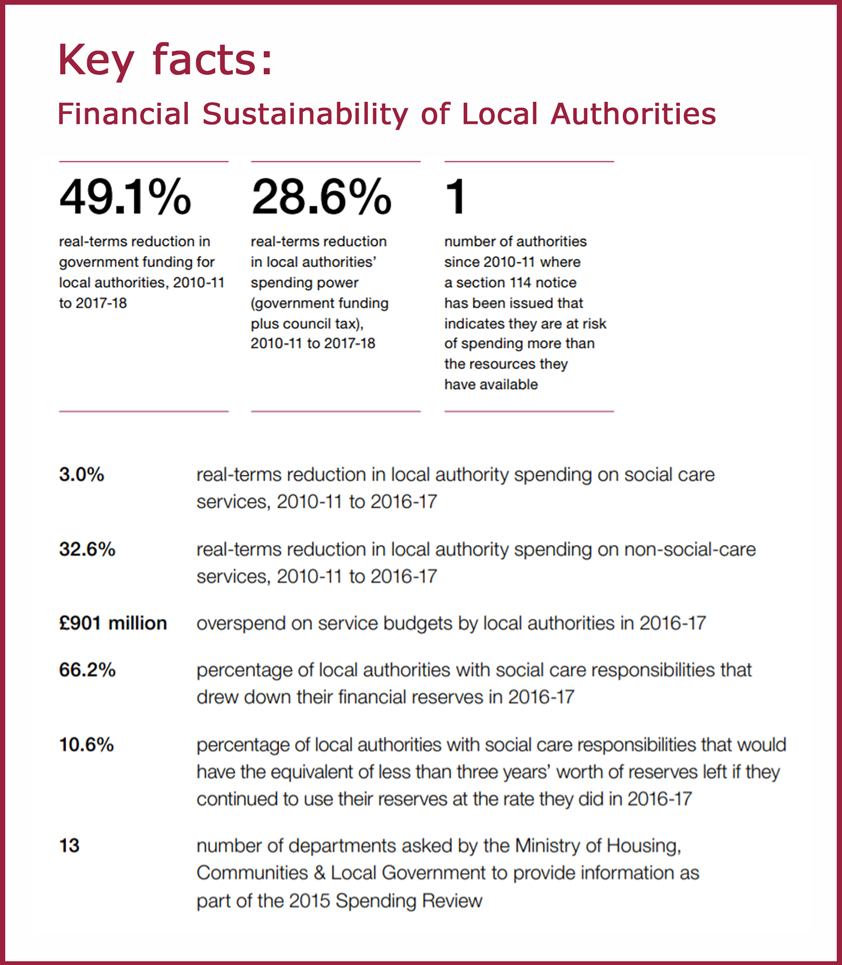 2019 will be a pivotal year for local government in England. Numerous difficult and open-ended questions need rapid resolution, at a time when government focus and capacity is directed elsewhere. Drawing on a number of our recent reports, here I explore some of the challenges facing the sector, from budget cuts and growing social care demands, to local service funding reforms and new risks from local government commercialisation.
2019 will be a pivotal year for local government in England. Numerous difficult and open-ended questions need rapid resolution, at a time when government focus and capacity is directed elsewhere. Drawing on a number of our recent reports, here I explore some of the challenges facing the sector, from budget cuts and growing social care demands, to local service funding reforms and new risks from local government commercialisation.
An uncertain financial future
Alongside central government funding cuts of nearly 50% since 2010-11, local authorities are facing strong demand and cost pressures, and no reduction in their statutory obligations to provide services. As we detail in our report, Financial Sustainability of Local Authorities 2018, local spending is becoming more narrowly focused on social care due to the statutory need to meet the growing demand and falling central government funding, alongside some council tax increases that are restricted to use only for adult social care. At the same time, income can be uncertain from other revenue sources, such as business rates, the New Homes Bonus, and fees and charges.

The upshot is that it is increasingly hard for authorities to find further savings and balance their books, resulting in a decline in non-social-care services, such as rubbish collection. Moreover, conditions attached to central government funding risk creating a centralised local authority financial system where the scope for local discretion is being eroded. Consequently, there is the real prospect that we will see another local authority join Northamptonshire County Council in issuing a Section 114 notice, which gives warning that it may not meet its legal obligation to ensure its revenues cover its spending.
Pending the 2019 Spending Review, certainty about local authority funding disappears from 2020-21. 2019-20 is the last year of the current four-year funding settlement, which provided some funding certainty and stability to support the medium-term planning of councils that accepted it – which was the vast majority of them.
But even during this four-year settlement, there have been numerous changes outside the settlement that have added to the uncertainty, further undermining strategic planning and creating significant risks for value for money. As our Financial Sustainability report observes, these changes have included the revised referendum limits, the re-purposing of some New Homes Bonus funding to support adult social care, the introduction of (and subsequent changes to) the adult social care precept, and multiple new adult social care funding announcements.
The uncertain future is compounded by not knowing whether local authorities’ retention of 75% of business rates will be the government’s preferred long-term funding mechanism for the sector, nor the outcome of the Fair Funding Review, which will determine the distribution of money from the Spending Review across authorities.
The strain of social care
 With some councils now spending almost 70% of their total revenue budgets on social care, perhaps of most interest to the sector is the long-awaited Social Care Green Paper. After much delay, it is now scheduled for publication in April 2019, but it remains to be seen whether it will propose anything radical enough to solve social care funding challenges, gain cross-bench support, or if there will be time in this Parliament to bring forwards the necessary legislation.
With some councils now spending almost 70% of their total revenue budgets on social care, perhaps of most interest to the sector is the long-awaited Social Care Green Paper. After much delay, it is now scheduled for publication in April 2019, but it remains to be seen whether it will propose anything radical enough to solve social care funding challenges, gain cross-bench support, or if there will be time in this Parliament to bring forwards the necessary legislation.
Furthermore, the Social Care Green Paper will only directly address adult social care issues, despite children’s social care being the area of local government spend under most financial strain. Our recent report, Pressures on children’s social care, sheds light on growth in these care needs and how this is being managed across the sector. The efficiency and outcomes of children’s services show amongst the greatest variation of any statutory local authority service area, and our report provides new insights to aid the debate about changes needed.
Health and social care integration
One area where we expect progress in 2019 is in health and social care integration; the NHS Long Term Plan is explicitly predicated on minimising avoidable pressures on hospitals from the social care system.
Our recent report on NHS Financial Sustainability identified a risk of NHS England not being able to make effective use of the addition to its budget of £20.5 billion by 2023-24, which the Prime Minister announced in June 2018. Nonetheless, partnership working on the ground across the health and social care sectors should accelerate thanks to the evolution of Sustainability and Transformation Partnerships (which are groupings of local hospitals, ambulance services, mental health providers, local authority, and other commissioners that plan services), and the first Integrated Care Systems. This would be helped by an intelligently designed successor to the Better Care Fund, though there are no signs of this at present.
 Although there are barriers and challenges to integration, we found positive signs in our report The health and social care interface (see also our post, Adult social care at a glance). Local government understands that central to addressing the impact of austerity and to improving patient outcomes is joint working across sectors, with service redesign focused on the needs of citizens. However, the extent to which Whitehall recognises this co-dependency will only be fully revealed when the Spending Review is delivered.
Although there are barriers and challenges to integration, we found positive signs in our report The health and social care interface (see also our post, Adult social care at a glance). Local government understands that central to addressing the impact of austerity and to improving patient outcomes is joint working across sectors, with service redesign focused on the needs of citizens. However, the extent to which Whitehall recognises this co-dependency will only be fully revealed when the Spending Review is delivered.
EU Exit
Local government is hardly the only sector struggling with the uncertainties around leaving the EU. But I believe that to date there has been an underestimation of the sector’s role and responsibilties in managing the impacts of a ‘no deal’ exit scenario.
Civil contingencies can only ever be dealt with at a local level. With only weeks left until our deadline for leaving the EU, much remains to be done to prepare for the potential emergency calls on local government and the Local Resilience Forums in which they play a key role.
EU structural funds, including national match funding, are currently worth £2.4 billion a year to the UK. So the UK’s exit from the EU also brings uncertainty about the size, distribution, and expectations of the UK Shared Prosperity Fund, which is planned to replace these EU funds. We expect decisions around its operation and priorities will be taken as part of the 2019 Spending Review.
Commercialisation
One way local authorities are responding to austerity and uncertainty is by increasing their commercial activities. The Secretary of State in the Coalition Government called for local authorities to become more entrepreneurial, and many have done just this.
Commercialisation isn’t simply investing in shopping centres – there are many other ways in which an authority can adopt a commercial mindset. But it’s the borrowing from the Public Works Loan Board and using this to invest in retail and other uses, such as office space, that has drawn the attention of HM Treasury, the Ministry for Housing, Communities and Local Government (MHCLG), and the Chartered Institute of Public Finance and Accountancy (CIPFA) – and rightly so, in my view.
 Such investment carries risks. At the same time, as our recent reports on Local auditor reporting and Local authority governance suggest, local authority governance has weakened in recent years. So it is not surprising that in December the MHCLG Minister, seeing some authorities borrowing upwards of 30 times their annual revenue budgets, suggested that the levels of borrowing in some authorities are too high, and it would be “prudent and quite frankly odd” if government didn’t look closely at them. Our report on local authority commercialisation, due this year, will shed useful light into this issue.
Such investment carries risks. At the same time, as our recent reports on Local auditor reporting and Local authority governance suggest, local authority governance has weakened in recent years. So it is not surprising that in December the MHCLG Minister, seeing some authorities borrowing upwards of 30 times their annual revenue budgets, suggested that the levels of borrowing in some authorities are too high, and it would be “prudent and quite frankly odd” if government didn’t look closely at them. Our report on local authority commercialisation, due this year, will shed useful light into this issue.
The year ahead
As well as the above, there are, of course, many other major areas of need that will impact on local government finances in the coming year – including housing and homelessness, education, and transport – many of which we will aim to cover in our work in the year ahead.
Perhaps more importantly, with responsibility for services dispersed across central government departments, each of which has its own narrow view of performance within its own service responsibilities, we have recommended that Whitehall build a more coherent understanding of, and coordinated approach to, local service delivery. With MHCLG acting in a coordinating role, government departments need to collectively build a consensus about the role and significance of local government as a whole in the context of the current funding climate, rather than each engaging with authorities solely to deliver their individual service responsibilities.
The nature of the UK’s exit from the EU, the Social Care Green Paper, and the Spending Review will all be pivotal in deciding what sort of future awaits local government. I and the NAO will observe with interest what progress has been made on the issues covered in this blog.
We welcome your comments, and I invite you to contact us contact us to discuss any of the issues raised in this post.



